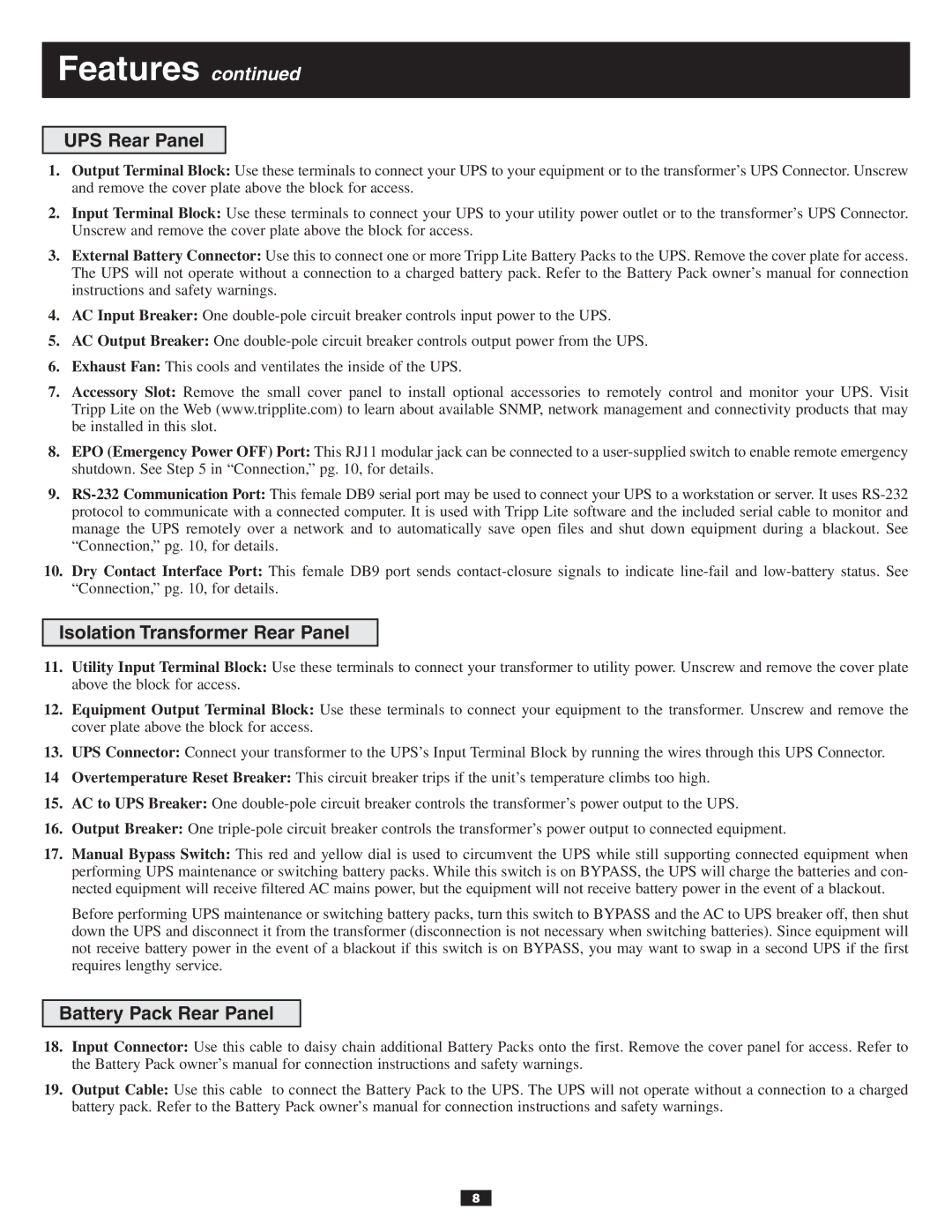
Features continued
UPS Rear Panel
1.Output Terminal Block: Use these terminals to connect your UPS to your equipment or to the transformer’s UPS Connector. Unscrew and remove the cover plate above the block for access.
2.Input Terminal Block: Use these terminals to connect your UPS to your utility power outlet or to the transformer’s UPS Connector. Unscrew and remove the cover plate above the block for access.
3.External Battery Connector: Use this to connect one or more Tripp Lite Battery Packs to the UPS. Remove the cover plate for access. The UPS will not operate without a connection to a charged battery pack. Refer to the Battery Pack owner’s manual for connection instructions and safety warnings.
4.AC Input Breaker: One
5.AC Output Breaker: One
6.Exhaust Fan: This cools and ventilates the inside of the UPS.
7.Accessory Slot: Remove the small cover panel to install optional accessories to remotely control and monitor your UPS. Visit Tripp Lite on the Web (www.tripplite.com) to learn about available SNMP, network management and connectivity products that may be installed in this slot.
8.EPO (Emergency Power OFF) Port: This RJ11 modular jack can be connected to a
9.
10.Dry Contact Interface Port: This female DB9 port sends
Isolation Transformer Rear Panel
11.Utility Input Terminal Block: Use these terminals to connect your transformer to utility power. Unscrew and remove the cover plate above the block for access.
12.Equipment Output Terminal Block: Use these terminals to connect your equipment to the transformer. Unscrew and remove the cover plate above the block for access.
13.UPS Connector: Connect your transformer to the UPS’s Input Terminal Block by running the wires through this UPS Connector.
14Overtemperature Reset Breaker: This circuit breaker trips if the unit’s temperature climbs too high.
15.AC to UPS Breaker: One
16.Output Breaker: One
17.Manual Bypass Switch: This red and yellow dial is used to circumvent the UPS while still supporting connected equipment when performing UPS maintenance or switching battery packs. While this switch is on BYPASS, the UPS will charge the batteries and con- nected equipment will receive filtered AC mains power, but the equipment will not receive battery power in the event of a blackout.
Before performing UPS maintenance or switching battery packs, turn this switch to BYPASS and the AC to UPS breaker off, then shut down the UPS and disconnect it from the transformer (disconnection is not necessary when switching batteries). Since equipment will not receive battery power in the event of a blackout if this switch is on BYPASS, you may want to swap in a second UPS if the first requires lengthy service.
Battery Pack Rear Panel
18.Input Connector: Use this cable to daisy chain additional Battery Packs onto the first. Remove the cover panel for access. Refer to the Battery Pack owner’s manual for connection instructions and safety warnings.
19.Output Cable: Use this cable to connect the Battery Pack to the UPS. The UPS will not operate without a connection to a charged battery pack. Refer to the Battery Pack owner’s manual for connection instructions and safety warnings.
8
